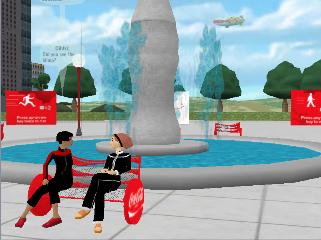Coca-Cola Re-Launches Coke Studios at There.com Virtual World

Coca-Cola, the world's most recognizable brand, is expanding its presence next week to virtual world There.com. Actually, it's more of a mass migration. Coke Studios(re-christened as CC Metro) has been up and running for the last five years and it has an eight million strong population, close to the population of Sweden and about the size of World of Warcraft. CC Metro will get a continent of its own-- shaped like the iconic Coke bottle -- on the Makena Technologies' platform. Coke's Interactive Brand Manager Jean Mertz, in an exclusive interview with Jack Myers Media Business Report, advises the move to There.com "allows us to give our community access to exclusive content from American Idol, the American Music Awards, NASCAR, NCAA, to athletes, trips, and events. There's no better way to do that than through a virtual experience."
Mertz and There.com CEO Michael Wilson confirm that There.com is scalable and can accommodate the millions of current and future CC Metro users. Working with design firm Imaginary Forces,which also created MTV's Virtual Laguna Beach, CC Metro's There.com continent will feature a five-story skateboarding park, complete with competitions and races, and a diner that will double as a casual dance club. Coke Theater will offer media performances, perhaps leveraging There.com's successful partnership with Capitol Music Group. Going forward, non-Coke marketers will be able to participate in CC Metro.
Reach senior ad execs. Advertise on JackMyers.com
Given the volume of advertisers running for the nearest virtual exit - particularly from Second Life - what do Coke and There.com know that other brands don't?
Without knocking the competition, Wilson is quick to offer what sets Makena Technologies apart fromLinden Labs(which operates Second Life): "We watched the hype over Second Life. Folks did not realize that they weren't purchasing the Brooklyn Bridge." But beyond the hyperbole, why did brands fail? "We find that brands don't succeed in-world when the vehicle hasn't been carefully thought out. Putting a Dell store in a virtual world was the silliest idea I've ever heard of. You need to make it engaging, and brand it with subtlety. Not billboards!"
Wilson then offers three operating principles:
1. When you bring a brand into a virtual world you have to put it where the people are.
2. You have to work with the brand, rather than just give them a patch of dirt and wish them luck.
3. You have to be like real life. You have to provide a sense that their stuff isn't going to be taken from them, a reference to copyright and trademark protection for brands.
While this may seem obvious, it's not Linden Labs' economic model. The same laissez-faire attitude that has made Second Life a hothouse for individual entrepreneurs pervades its approach to brands. In an article on Worlds In Motion, Matt Daly of Metaversatility, a virtual world development company that has worked with both There.com and Second Life, remarks that “Second Life is not very good for third parties because Linden doesn’t work with [them]; they’re very hands-off as much as they can, and then its our de facto role to come in and know the tools, know the landscape and then develop with whatever we have. You can’t get any further than the way it should be than a platform where you have no real contact with the developers of the platform. It’s very democratic, but for actual third-party developers, it’s not the most efficient way to go."
Read TiVo-Worthy TV Everyday at JackMyers.com
Not that Coca-Cola needs handholding. Having been in the space (albeit, 2-D) for a number of years means that they understand engagement, as well as brand identity and loyalty within virtual worlds. Mertz agrees with Wilson. "A lot of other companies jumped in without a lot of analysis. Our history in virtual worlds and MMOGs (Massive Multiplayer Online Games) means that we have a deep understanding of social networks and community. We wanted to do what was going to be best for the community. Makena can provide a fantastic level of functionality, platform stability, and an opportunity for creative growth."
In a Gartner Group report by analyst Steven Prentice earlier this spring, updated in the fall, criticism was leveled at virtual spaces that did not pay enough attention to administration and security – i.e., platform stability. It predicted that the success stories would come from worlds that were heavily moderated, targeted, and sensitive to branding issues. This pretty much fits Makena to a T. The company had already executed Virtual Laguna Beach for MTVN (see our coverage here) and thus knew the demo intimately. In fact, while Second Life skews towards thirtysomethings, There.com runs about ten years younger. And whereas Second Life has a Red Light district, There.com is resolutely PG-13.
Mertz reports that the collaboration wasn't a one-off but that it was part of a "global corporate decision" by Coca-Cola. In particular, it allows them to seamlessly promote their Coke Side of Life campaign. Offers Mertz, "When we were first developing Coke Studios it stood for positivity and emanated optimism. We want to make sure this is continued in our CC Metro space as well. Part of that is connecting our consumers with one another."
For further information, contact There.com CEO Michael Wilson at michael@thereinc.com.


